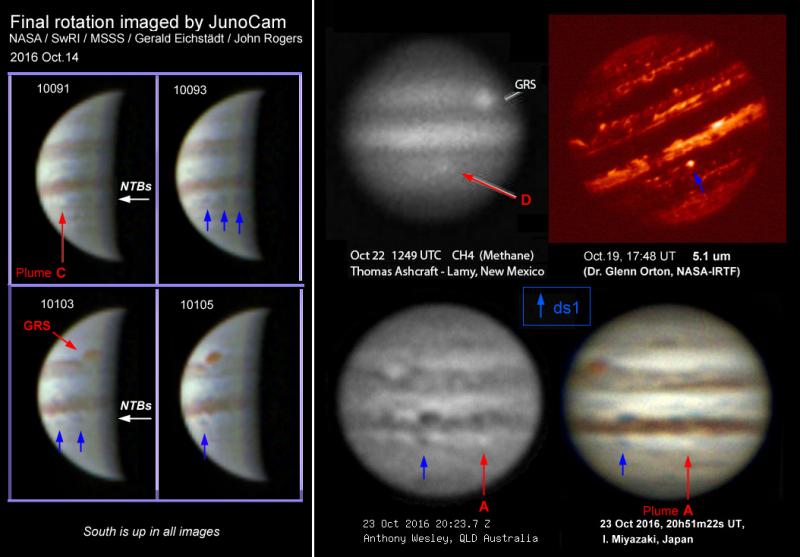2016 November 1
Jupiter’s new outbreak tracked
The dramatic new outbreak of storms on Jupiter’s fastest jet-stream, predicted over a year ago and discovered at the very start of this apparition, has now been tracked by the BAA Jupiter Section. A detailed report up to Oct.25 has been posted on our web pages at:
https://www.britastro.org/node/8102
The outbreak on the North Temperate Belt (NTB) was discovered on Oct.19, when infrared imaging by Dr Glenn Orton revealed two brilliant cloud plumes, just as the Juno spacecraft was drifting passively through its second perijove. We were able to track the phenomenon using very distant Juno images taken from Oct.11-14 before its shut-down, and also in images taken in the dawn skies by amateurs from Oct.21 onwards. It started during solar conjunction, probably in mid-September, and by Oct.14 there were 3 or 4 brilliant plumes on the super-fast jet-stream, with a long chain of very dark bluish-grey spots following them. By Oct.25 this disturbance had spread around the planet and just two of the plumes remained. Its speed and development have been fully consistent with previous such outbreaks. Below is a sample of images from the report.
As the planet moves further from the Sun, more amateurs have begun to image it in the dawn sky. On Oct.28-30, the last two super-fast plumes caught up with the slower-moving dark spots, and at least one of them has disappeared, as they usually do. So now the outbreak consists of rapidly-changing dark spots and streaks all around the planet, which are expected to reconstitute the North Temperate Belt over the coming months, probably with vivid coloration as well.
Meanwhile, here are some updates on the Juno mission:
>> We have compiled a map of the planet from the images taken just before and after the first perijove on August 27. This is posted on the JunoCam web site, and on the BAA Jupiter Section web site at:
https://britastro.org/node/8126.
>> Juno has been reactivated out of ‘safe mode’, and the next (third) perijove will be on Dec.11. It is planned to collect a full set of observations from all instruments then.
>> The problem with sticky engine valves is not yet resolved, so the engine burn to reduce the orbital period to 14 days has not been rescheduled. The provisional plan is to keep Juno in its present 53.5-day orbit, probably at least until summer 2017, but a more definite plan may be made in the coming weeks. It will be possible to carry out the complete mission in the present orbit, but it will take much longer than intended.
–John Rogers (BAA), 2016 Nov.1

| The British Astronomical Association supports amateur astronomers around the UK and the rest of the world. Find out more about the BAA or join us. |
